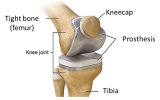Functional Ankle Motion After Ankle Syndesmosis Injury Repair: A Comparison of Suture-Button and Cortical-Screw Fixation Surgeries
Background and Purpose: A syndesmosis injury, also known as a "high ankle sprain" is a type of ankle sprain that involves the ligaments that hold the bottom of the two shinbones together (tibia and fibula). When disrupted, the stability of the ankle is compromised and surgery is often necessary. Two types of surgeries are routinely performed (the "cortical screw" and "suture button" techniques) but there is currently no agreement on which provides the best outcome after recovery. The purpose of this study is to compare ankle motion between people who have had one of the two surgical techniques. Ankle motion will be assessed during walking and a while descending a step.
Influence of Lumbar Spine Fusion on Total Hip Replacement Patients
Purpose: To investigate the long-term functional status of individuals having had both a total hip replacement and an instrumental lumbar spine fusion. The primary objective will be to access the spine-pelvis-hip changes that occur during a sit to stand task in patients that have had both a THA and a lumbar fusion and compare it to a group of patients that have had a THA alone. Secondary objectives will be to compare pain and functional status between these two groups of patients.
Why do People with Chronic Low Back Pain Move Differently? The Influence of Biopsychosocial Variables on Movement Variability
Study Purpose: The purpose of this investigation is to determine the extent to which psychological factors (pain-related fear and pain catastrophizing), and measures of pain sensitivity (SPA, quantitative sensory testing), explain observed motor behavior during functional tasks in adults with chronic Low Back Pain.
Does Structural Damage, Joint Mechanics, or Neuromuscular Variables Predict Early Osteoarthritic Changes Following Knee Trauma
Background: Knee trauma often leads to the development of knee osteoarthritis, which is a disease resulting in joint degeneration. The purpose of the study is to determine if damage to knee tissues and changes in joint motion predict early signs of knee osteoarthritis.
Eligibility: Individuals 18-50 years of age, who have sustained knee trauma within 4 months that led to damage of structures within the knee (e.g. meniscus, ligaments).
Contact: Interested participants should contact shawn.robbins [at] mcgill.ca (Dr. Shawn Robbins) or phone: 514-487-1891 x194.
